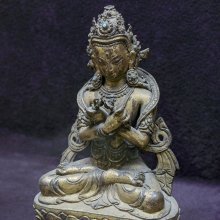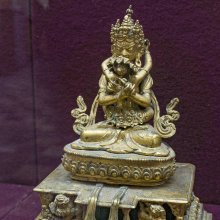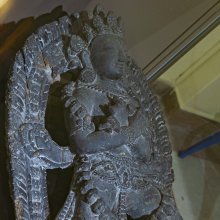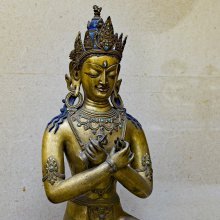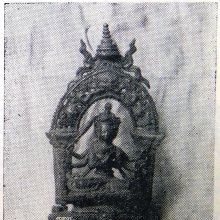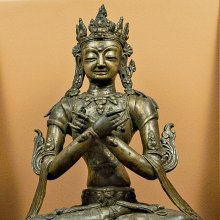Vajradhara, Vajradhāra, Vajra-dhara: 19 definitions
Introduction:
Vajradhara means something in Buddhism, Pali, Hinduism, Sanskrit, Jainism, Prakrit, Marathi. If you want to know the exact meaning, history, etymology or English translation of this term then check out the descriptions on this page. Add your comment or reference to a book if you want to contribute to this summary article.
Images (photo gallery)
(+5 more images available)
In Hinduism
Ayurveda (science of life)
Rasashastra (Alchemy and Herbo-Mineral preparations)
Source: Wisdom Library: Rasa-śāstraVajradhara (वज्रधर) is the name of an Ayurvedic recipe defined in the fourth volume of the Rasajalanidhi (chapter 3, grahaṇī: chronic diarrhoea). These remedies are classified as Iatrochemistry and form part of the ancient Indian science known as Rasaśāstra (medical alchemy). However, as an ayurveda treatment, it should be taken twith caution and in accordance with rules laid down in the texts.
Accordingly, when using such recipes (e.g., vajra-dhara-rasa): “the minerals (uparasa), poisons (viṣa), and other drugs (except herbs), referred to as ingredients of medicines, are to be duly purified and incinerated, as the case may be, in accordance with the processes laid out in the texts.” (see introduction to Iatro chemical medicines)

Āyurveda (आयुर्वेद, ayurveda) is a branch of Indian science dealing with medicine, herbalism, taxology, anatomy, surgery, alchemy and related topics. Traditional practice of Āyurveda in ancient India dates back to at least the first millenium BC. Literature is commonly written in Sanskrit using various poetic metres.
Shaktism (Shakta philosophy)
Source: Google Books: ManthanabhairavatantramVajradhara (वज्रधर) refers to one of the male servants associated with Kāmarūpa, one of the sacred seats (pīṭha), according to the Manthānabhairavatantra, a vast sprawling work that belongs to a corpus of Tantric texts concerned with the worship of the goddess Kubjikā.—Nine of the twelve female servants (three in each of the first four seats), are low-caste women who we find, in other contexts, embody the Mothers (mātṛkā). The maids (cellakā) are Yoginīs and the servants their male counterparts [i.e., Vajradhara]. These replace the spiritual ‘sons’ and ‘daughters’ the goddess generates and the guardians she appoints in the sacred seats listed in the ‘Kubjikāmatatantra’.

Shakta (शाक्त, śākta) or Shaktism (śāktism) represents a tradition of Hinduism where the Goddess (Devi) is revered and worshipped. Shakta literature includes a range of scriptures, including various Agamas and Tantras, although its roots may be traced back to the Vedas.
In Buddhism
Tibetan Buddhism (Vajrayana or tantric Buddhism)
Source: Google Books: Mahāmudrā and Related InstructionsVajradhara (वज्रधर) is the name of an ancient teacher, according to “the succession of Gurus in the Mahāmudrā lineages” in the Kagyü School of Tibetan Buddhism (the Mahāmudrā deals with the nature of the mind).—According to the special Mantrayāna tradition, one lineage is: (1) Vajradhara, (2) Tilopa, (3) Nāropa, and (4) Marpa Lotsāwa. Another lineage is: (1) Vajradhara, (2) Matiratna, (3) Saraha, [(4) Nāgārjuna], (5) Śavaripa, (6) Maitripa, and (7) Marpa Chökyi Lodrö. Afterward, both lineages merge in Lord Milarepa, Lord Daö Shönu [i.e., Gampopa], and so on. This is the lineage of the Kamtsang [Kagyü]. [...]
Source: archive.org: The Indian Buddhist IconographyVajradhara (वज्रधर) or the Ādibuddha is supposed to be the originator of the five Dhyāni Buddhas, the progenitors of the five Kulas or families of Buddhist gods and goddesses.
Vajradhara is the principal deity in the Vajrasattva-maṇḍala in the Niṣpannayogāvalī. His colour is reddish-white; he has three faces; six arms and his pose is Tāṇḍava Dance.—Accordingly: “In the innermost chamber of the Maṇḍala there is Vajradhara. His colour is reddish white. He is three-faced. The right face is blue and the left is red. He is six-armed. With the two principal hands carrying the vajra and the ghaṇṭā he embraces the prajñā. The two other right hands show the excellent sword and the aṅkuśa. In the two remaining left hands, he carries the kapāla and the noose. He stands in the ardhaparyaṅka and dances the tāṇḍava dance exhibiting the nine dramatic sentiments”.
Source: academia.edu: The Structure and Meanings of the Heruka MaṇḍalaVajradhara (वज्रधर) is the name of a Vīra (hero) who, together with the Ḍākinī named Vajradharī forms one of the 36 pairs situated in the Hṛdayacakra, according to the 10th century Ḍākārṇava chapter 15. Accordingly, the hṛdayacakra refers to one of the four divisions of the sahaja-puṭa (‘innate layer’), situated within the padma (lotus) in the middle of the Herukamaṇḍala. The 36 pairs of Ḍākinīs and Vīras [viz., Vajradhara] are reddish yellow in color; they each have one face and four arms; they hold a skull bowl, a skull staff, a small drum, and a knife.
Source: OSU Press: Cakrasamvara SamadhiVajradhara (वज्रधर) refers to “holding a vajra” and is used to describe Śrī Vajrasattva, according to the Guru Mandala Worship (maṇḍalārcana) ritual often performed in combination with the Cakrasaṃvara Samādhi, which refers to the primary pūjā and sādhanā practice of Newah Mahāyāna-Vajrayāna Buddhists in Nepal.—Accordingly, “Oṃ in the middle of mantra inhabited ground, arisen of the four seeds, yaṃ, etc., a maṇḍala of the great elements, wind, fire, water, and earth, Above that, (arising from) the letter suṃ, is the merumaṇḍala, Above that, on a jeweled lion-throne, lotus, and a lunar-disc, Śrī Vajrasattva, two arms, one face, white color, Holding a vajra (and) vajra-bell (vajradhara—vajravajraghaṇṭādharaṃ), (and) adorned wearing various colors, Bearing a monk’s headdress, (and) a sapphire Akṣobhya adorned crown, Thus imagine the worshipful guru[...]”.
Source: De Gruyter: Himalayan Anthropology: The Indo-Tibetan InterfaceVajradhāra (वज्रधार) refers to the “Vajra bearer” (visualized as situated at the center of the sacred tree—Tibetan: tshog shin), according to William Stablein’s A Descriptive Analysis of the Content of Nepalese Buddhist Pujas as a Medical-Cultural System (with References to Tibetan Parallels).—The tshog shin (sacred tree) is also mentally visualized.—[...] The essence of the tree is the bīja [seed], which has an empty center from which the divinity is imagined to grow. [...] In the center of the sacred tree there is the supreme vajradhāra [Vajra bearer], the iṣṭadevatā [tutelary deity] sits below, and surrounding the tree at the bottom are the nātha [protectors]. These three can be likened unto a seed: the center, the embryo, and the protective layer, respectively. It is believed that the divinities are actually not different from each other in essence, which at least is known and realized by most hierophants (varjācārya).

Tibetan Buddhism includes schools such as Nyingma, Kadampa, Kagyu and Gelug. Their primary canon of literature is divided in two broad categories: The Kangyur, which consists of Buddha’s words, and the Tengyur, which includes commentaries from various sources. Esotericism and tantra techniques (vajrayāna) are collected indepently.
Mahayana (major branch of Buddhism)
Source: De Gruyter: A Buddhist Ritual Manual on AgricultureVajradhara (वज्रधर) is the name of a deity (to be painted on a flagstaff as part of a pacification ritual), according to the Vajratuṇḍasamayakalparāja, an ancient Buddhist ritual manual on agriculture from the 5th-century (or earlier), containing various instructions for the Sangha to provide agriculture-related services to laypeople including rain-making, weather control and crop protection.—Accordingly, [As the Bhagavān teaches a pacification ritual]: “A pacification rite should be performed at four places in the field. [...] One should paint the glorious Buddha, Agastya Ṛṣi and Vajradhara and it should be mounted at the top of a flagstaff in an elevated place. Flowers and incense of offering should be given. A stake made of khadira wood measuring eight aṅgulas should be [enchanted] a thousand times and driven into the ground on the top of a dwelling. [...]”.

Mahayana (महायान, mahāyāna) is a major branch of Buddhism focusing on the path of a Bodhisattva (spiritual aspirants/ enlightened beings). Extant literature is vast and primarely composed in the Sanskrit language. There are many sūtras of which some of the earliest are the various Prajñāpāramitā sūtras.
In Jainism
General definition (in Jainism)
Source: archive.org: Een Kritische Studie Van Svayambhūdeva’s PaümacariuVajradhara (वज्रधर) participated in the war between Rāma and Rāvaṇa, on the side of the latter, as mentioned in Svayambhūdeva’s Paumacariu (Padmacarita, Paumacariya or Rāmāyaṇapurāṇa) chapter 57ff. Svayambhū or Svayambhūdeva (8th or 9th century) was a Jain householder who probably lived in Karnataka. His work recounts the popular Rāma story as known from the older work Rāmāyaṇa (written by Vālmīki). Various chapters [mentioning Vajradhara] are dedicated to the humongous battle whose armies (known as akṣauhiṇīs) consisted of millions of soldiers, horses and elephants, etc.

Jainism is an Indian religion of Dharma whose doctrine revolves around harmlessness (ahimsa) towards every living being. The two major branches (Digambara and Svetambara) of Jainism stimulate self-control (or, shramana, ‘self-reliance’) and spiritual development through a path of peace for the soul to progess to the ultimate goal.
Languages of India and abroad
Marathi-English dictionary
Source: DDSA: The Molesworth Marathi and English Dictionaryvajradhāra (वज्रधार).—a S Exquisitely sharp or keen.
Marathi is an Indo-European language having over 70 million native speakers people in (predominantly) Maharashtra India. Marathi, like many other Indo-Aryan languages, evolved from early forms of Prakrit, which itself is a subset of Sanskrit, one of the most ancient languages of the world.
Sanskrit dictionary
Source: DDSA: The practical Sanskrit-English dictionaryVajradhara (वज्रधर).—
1) an epithet of Indra; वज्रधरप्रभावः (vajradharaprabhāvaḥ) R.18.21.
2) an owl.
Derivable forms: vajradharaḥ (वज्रधरः).
Vajradhara is a Sanskrit compound consisting of the terms vajra and dhara (धर).
Source: Cologne Digital Sanskrit Dictionaries: Edgerton Buddhist Hybrid Sanskrit DictionaryVajradhara (वज्रधर).—(compare Vajrapāṇi?), name of a Bodhisattva or deity: (Ārya-)Mañjuśrīmūlakalpa 312.6; Sādhanamālā 515.4 etc.
--- OR ---
Vajradharā (वज्रधरा).—name of a rākṣasī: Mahā-Māyūrī 243.22.
Source: Cologne Digital Sanskrit Dictionaries: Shabda-Sagara Sanskrit-English DictionaryVajradhara (वज्रधर).—m.
(-raḥ) 1. Indra, as the Jupiter Tonans of the Hindus. 2. A Baud'dha saint. E. vajra the thunder-bolt, dhara who has or holds.
Source: Cologne Digital Sanskrit Dictionaries: Benfey Sanskrit-English DictionaryVajradhara (वज्रधर).—[vajra-dhara], and vajrabhṛt vajra-bhṛ + t, m. Indra, [Rāmāyaṇa] 3, 53, 60; [Lassen, Anthologia Sanskritica.] 2. ed. 76, 49.
Source: Cologne Digital Sanskrit Dictionaries: Cappeller Sanskrit-English DictionaryVajradhara (वज्रधर).—[adjective] wielding the thunderbolt ([Epithet] of Indra).
Source: Cologne Digital Sanskrit Dictionaries: Monier-Williams Sanskrit-English Dictionary1) Vajradhara (वज्रधर):—[=vajra-dhara] [from vajra > vaj] mfn. holding a thunderbolt
2) [v.s. ...] m. Name of Indra, [Mahābhārata; Kāvya literature] etc.
3) [v.s. ...] of a Bodhi-sattva (= vajra-pāṇi), [Monier-Williams’ Buddhism 195; 201]
4) [v.s. ...] of a king, [Rājataraṅgiṇī]
5) Vajradhāra (वज्रधार):—[=vajra-dhāra] [from vajra > vaj] mfn. whose edge or point is as hard as a diamond.
Source: Cologne Digital Sanskrit Dictionaries: Yates Sanskrit-English DictionaryVajradhara (वज्रधर):—[vajra-dhara] (raḥ) 1. m. Indra; Jaina sage.
[Sanskrit to German]
Sanskrit, also spelled संस्कृतम् (saṃskṛtam), is an ancient language of India commonly seen as the grandmother of the Indo-European language family (even English!). Closely allied with Prakrit and Pali, Sanskrit is more exhaustive in both grammar and terms and has the most extensive collection of literature in the world, greatly surpassing its sister-languages Greek and Latin.
Kannada-English dictionary
Source: Alar: Kannada-English corpusVajradhara (ವಜ್ರಧರ):—[noun] Indra, the chief of gods, whose weapon is thunderbolt.
Kannada is a Dravidian language (as opposed to the Indo-European language family) mainly spoken in the southwestern region of India.
See also (Relevant definitions)
Partial matches: Dhara, Vajra, Tara.
Starts with: Vajradharana, Vajradharaprabhava.
Query error!
Full-text (+29): Guhyapati, Vajradharaprabhava, Vajrapani, Vajrabhrit, Candavajradhara, Vaccirataran, Nagarjuna, Gampopa, Saraha, Marpa lotsawa, Matiratna, Milarepa, Dao shonu, Kamtsang, Naropa, Maitripa, Marpa chokyi lodro, Samantabhadra, Tilopa, Shavaripa.
Relevant text
Search found 23 books and stories containing Vajradhara, Vajra-dhara, Vajra-dhāra, Vajradhāra, Vajradharā; (plurals include: Vajradharas, dharas, dhāras, Vajradhāras, Vajradharās). You can also click to the full overview containing English textual excerpts. Below are direct links for the most relevant articles:
The Six Yogas of Naropa (by C. A. Musés)
Rasa Jala Nidhi, vol 4: Iatrochemistry (by Bhudeb Mookerjee)
Part 35 - Treatment for chronic diarrhea (7): Vajra-dhara rasa < [Chapter III - Jvaratisara fever with diarrhoea]
The Indian Buddhist Iconography (by Benoytosh Bhattachacharyya)
Figure 16 - Vajradhara, Six-armed (Baroda Museum)
Figure 13 - Vajradhara (Baroda Museum)
The gods of northern Buddhism (by Alice Getty)
The Buddhist Path to Enlightenment (study) (by Dr Kala Acharya)
4.1. The Meaning of Indriya (Faculties) < [Chapter 2 - Five Groups of Factor]
Iconography of Buddhist and Brahmanical Sculptures (by Nalini Kanta Bhattasali)
Related products
